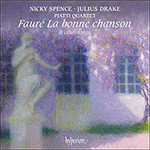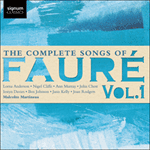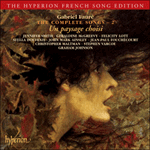On the composer’s return to Paris after the upheavals of the Commune he heard Duparc’s new masterpiece
L’invitation au voyage. That work is a turning point in French song; it also introduced Fauré to Baudelaire’s work and encouraged him to consider moving away from composing romances to the long poems of Hugo. Instead he began to tackle shorter poems by younger poets that had the power to create a more intense musical atmosphere. Leconte de Lisle’s
Lydia (No XVII of the ‘Études latines’ section of his
Poèmes antiques of 1852) was an ideal match with the composer’s new espousal of the mélodie. The simplicity of the music on the page belies a stunning new sophistication in Fauré’s approach. The vocal line is shadowed by the voice adding to the Attic purity of the evocation; the attenuated piano-writing avoids anything unseemly or immodest. An ancient Greek atmosphere is created partly by use of the Lydian mode, the sharpened fourth of the scale. This gentle exoticism adds to the music’s rarefied charm; it is as if we are breathing the air of Parnassus (the marvellous postlude dissolves into those ethereal regions more convincingly than the ascension depicted in Schubert’s
Ganymed). At ‘tes baisers de colombe’ the undulating vocal line, accompanied by gently fluting thirds, is the most convincing illustration of cooing doves in all song. Dove imagery is welcomed; Leconte de Lisle’s description of Lydia’s neck being as ‘fresh and pale as milk’ is another matter! Confronted with the poet’s ‘Et sur ton col frais, et plus blanc / Que le lait’ Fauré, with devilish cunning, changes ‘plus’ to ‘si’ and simply leaves out ‘Que le lait’, allowing ‘blanc’ to link with the next verb ‘roule’. A piano interlude (bars 6 to 7) stands in for the judicious cut. If this song owes its existence to Duparc, that composer’s
Phydilé was certainly inspired by
Lydia, as was Chausson’s
Hébé (all three song heroines were Leconte de Lisle’s Grecian nymphs).
from notes by Graham Johnson © 2005
English: Hypérion
De retour à Paris, après le branle-bas de la commune, Fauré entendit le nouveau chef-d’œuvre de Duparc,
L’invitation au voyage. Cette pièce, qui marque un tournant dans la mélodie française, fut aussi celle qui initia Fauré à l’œuvre baudelairien, qui l’incita à se départir de ses romances sur de longs poèmes hugoliens. Dès lors, il s’attaqua à des poèmes plus courts, signés d’auteurs plus jeunes, à même de créer une atmosphère musicale plus intense.
Lydia de Leconte de Lisle (noXVII des «Études latines» tirées de ses
Poèmes antiques, 1852) convint idéalement à ces nouvelles noces fauréennes avec la mélodie. La simplicité de la musique, sur le papier, dément une sophistication étonnamment neuve de l’approche de Fauré. La ligne vocale, filée par la voix, ajoute à la pureté attique de l’évocation, cependant que l’écriture pianistique atténuée évite tout ce qui serait inconvenant ou immodeste. Un parfum de Grèce antique naît en partie de l’usage du mode lydien, la quarte diésée de la gamme – un doux exotisme qui exacerbe le charme raffiné de la musique; c’est comme si nous humions l’air du Parnasse (le merveilleux postlude se fond de manière plus convaincante dans ces sphères éthérées que l’ascension dépeinte par Schubert dans
Ganymed). À «tes baisers de colombe», la ligne vocale flexueuse, accompagnée de tierces discrètement flûtées, est, de toute cette mélodie, l’illustration la plus probante de colombes en train de roucouler. L’image de la colombe est bienvenue; la description que Leconte de Lisle fait du col de Lydia, «frais et blanc comme le lait», est une autre affaire! Confronté au «Et sur ton col frais, et plus blanc / Que le lait» du poète, Fauré, avec une finesse diabolique, change le «plus» en «si» et supprime carrément «Que le lait», laissant l’adjectif «blanc» faire le lien avec le verbe suivant, «roule». Un interlude pianistique (mes. 6 à 7) assure une césure judicieuse. Si cette mélodie doit son existence à Duparc,
Phydilé, du même Duparc, fut, elle, certainement inspirée par
Lydia, qui inspira aussi
Hébé de Chausson (ces trois héroïnes de mélodies étant des nymphes grecques de Leconte de Lisle).
extrait des notes rédigées par Graham Johnson © 2005
Français: Hypérion
Lydia, dessen musikalische Sprache sich in
La bonne chanson wiederfindet, stammt aus der Zeit um 1870 und ist ein gutes Beispiel dafür, wie sich Fauré im Alter von etwa 25 Jahren von blumigen, diskursiven Vertonungen der Gattung „Romanze“ zu einer neuen, konzentrierten Herangehensweise an die anspruchsvollere „mélodie“ entwickelte. Seine Inspirationsquellen waren unter anderem die Lieder seines Freundes Henri Duparc, dessen Baudelaire-Vertonung
L’invitation au voyage im selben Jahr veröffentlicht wurde.
Lydia legt eine Melodie von honigsüßer Schönheit vor, die durch die Verwendung des lydischen Modus (jene übermäßige Quarte) ein klangliches Wortspiel darstellt.
aus dem Begleittext von Jessica Duchen © 2025
Deutsch: Viola Scheffel


 Fauré: La bonne chanson & other songs
Fauré: La bonne chanson & other songs Fauré: The Complete Songs, Vol. 1
Fauré: The Complete Songs, Vol. 1 Fauré: The Complete Songs, Vol. 2 - Un paysage choisi
Fauré: The Complete Songs, Vol. 2 - Un paysage choisi
